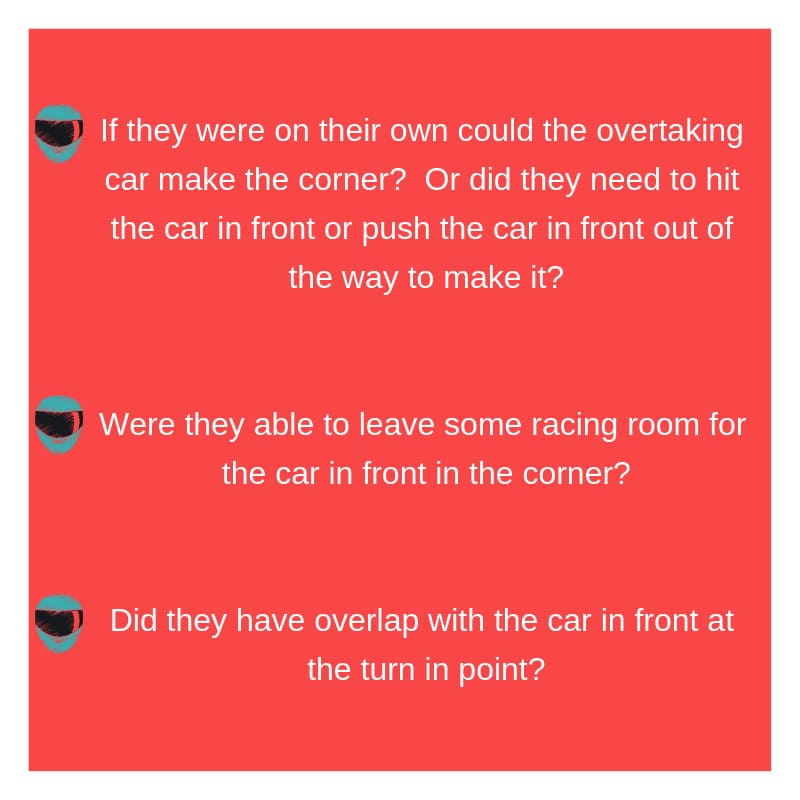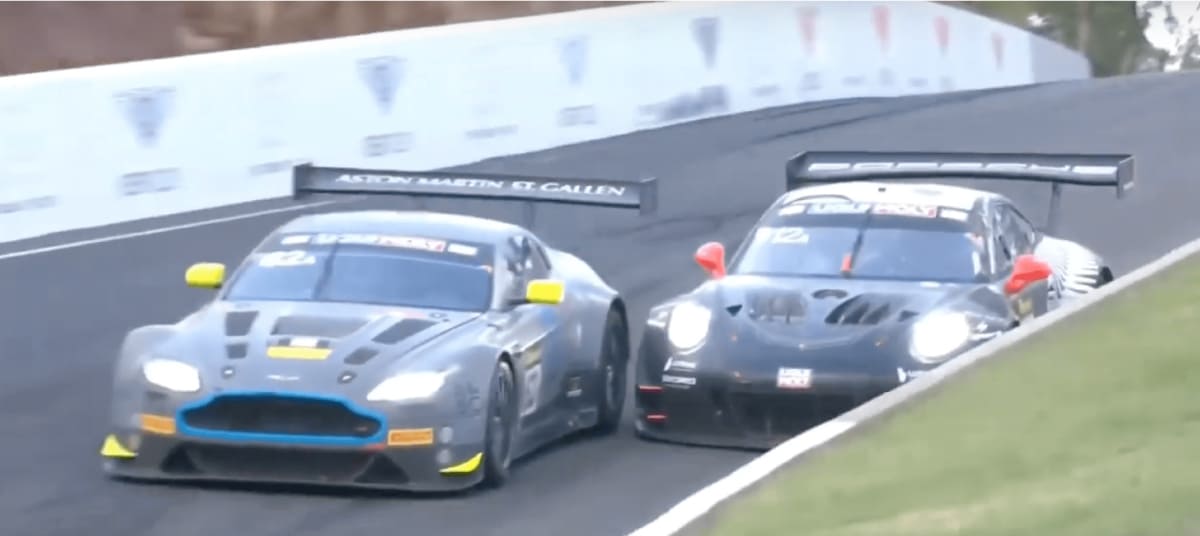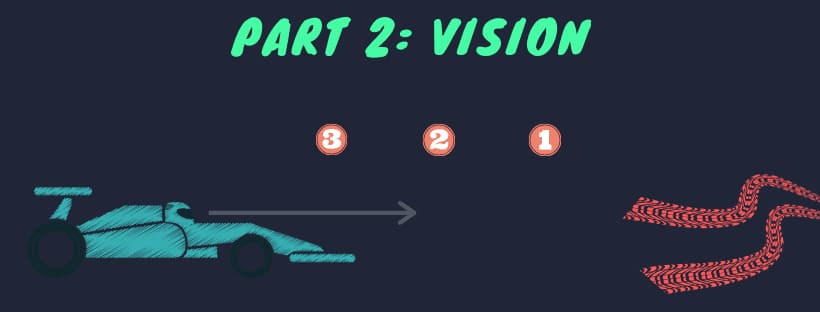The best overtakers have the right mix of timing, aggression, creativity, and feeling for the driver they are attempting to overtake. Without building the right mix of these four things overtaking becomes less of a decisive move and more of a “close my eyes and hope this works.”
Racecraft is extremely hard to teach because every overtaking move will be different. Every driver you are battling with has a different aggression and awareness level, and every car you battle has different strengths and weaknesses.
In this article, we are going to break down some key points to think about while working on overtaking. And hopefully, start turning yourself into a race-winning driver from any starting position on the grid!
We will start with a pass from 2019 that amazed everyone. The pass starts 24 seconds into this following video.
This was one amazing pass, but it's not one we are going to recommend for amateur racers. Let’s break down the four key points of a good overtake and what he did well and why it may not be the best guidance for overtaking in amateur racing.
1) Timing
Here Matt Cambell was picture-perfect. He is not giving the car in front any idea that he is thinking about trying a pass here. If he had looked to the inside any earlier, it would have been easy for the Aston driver to glance in their mirrors and let the car drift slightly to the inside and block any line for Matt to attack.
Matt waits for the Aston to begin its braking and open the door before shooting to the inside. He gets some overlap with the Aston before turn in to establish his position and spot on the track.
2) Aggression
Matt is very aggressive with this move, and there is a small touch between the two cars. But is he over-aggressive?
With the race on the line, he knows he needs to make something happen but doesn’t let desperation turn into a dive bomb maneuver. We are looking for the following two things to determine if it is an over-aggressive pass:

It’s obvious here Matt would have been able to take the corner by himself and that he left racing room for the Aston throughout the corner. They did have the small touch but that was more the Aston not giving Matt quite enough room.

Here we are looking at the turn in point. We can see Matt has done a great job getting alongside roughly 1/3rd of the Aston before the turn in point and still getting his car slowed down enough to not need to hit the Aston after turn in. It’s this part right here that is probably the hardest thing to do and what made this pass so damn good.
3) Creativity
Anyone watching this race live knew Matt was faster and on fresher tires. We knew he was probably going to be able to make a pass happen, but I don’t think anyone thought it was going to happen like this.
For creativity, Matt gets a perfect 10 out of 10. He caught the Aston driver by surprise with a very decisive but controlled move.
4) Feeling for the Driver They Are Trying to Overtake
This overtake took more than Matt perfecting the first three steps. It took an aware Aston Martin driver giving him room and knowing where Matt was. Even with a perfectly timed pass with the right amount of aggression and creativity this very easily could have ended in tragedy with both cars out of the race.
Matt knew who he was racing with and trusted the driver in front to have enough awareness to see Matt and to be a respectful enough driver to give Matt the room he needed.
It is this point right here why this isn’t a pass we would recommend amateur racing drivers to study. The awareness of the vast majority of drivers in amateur racing just isn’t at the level of a pro driver. In most cases, the driver in front would have not seen the Porsche dive to the inside at the last second.
I have experienced this many times even at all levels. I am battling with a car in front I know that they just don’t have the awareness for me to pass unless I get fully alongside them before the turn in point. That means I just know certain areas of the track it is not worth attempting the pass because their full focus is on themselves.
This does significantly negate the amount of creativeness a driver can use in their overtaking. But as we learn the drivers around us, and hopefully increase the education of all drivers in amateur motorsports, we can build the awareness skill in all drivers and build back the creativeness of overtaking in amateur racing.
Obviously, the more you race with someone the more you learn about them as drivers, and when you come across those aware drivers then use all the creativity you can!
Important Points for Amateur Racing
As you work on building up your racecraft we want you to keep some major points in mind. If we had to stress two things that all racers need to remember it would be the following.
Patience
You don’t need to pass the person the exact moment you catch them. Having patience for a lap or more will SIGNIFICANTLY improve your chances of pulling off a successful pass. This will allow you to get an understanding of the awareness of the car in front, learn their weaknesses, and strike at the right point.
Decisiveness
Build your strategy for where you can overtake a car while losing the least amount of time. We often see drivers pull to the inside and just hope the car in front sees them and will let them by.
This likely causes the car in front to slow up because they are scared you will dive bomb and then the car behind doesn’t know if the car in front is letting them by or if they see them at all so they slow up. The only thing that gets accomplished here is that both cars slow down.
Be patient, find your spot, and when the opportunity opens up, strike!
We have a great article on the right way to start a pass and show your nose here
Now that you know the art of “showing your nose” as we are preparing to strike we want to suck up as close to the car in front as possible and stay right behind them. If we are on a straight don’t pull out of line too early, wait until you are approaching the braking zone, and then make your move to get alongside the car in front. At this moment a driver’s vision becomes critical.
Be patient, find your spot, and when the opportunity opens up, strike!

As we are beginning to get alongside the car in front and make our overtaking move we need to be very disciplined with our eyes. At this point, my eyes are focused on two separate areas.
First, I am looking far ahead and trying to identify my brake marker. I keep in mind if I am offline, I may have less grip - so I will likely need to brake slightly earlier than I usually do. If we are offline the closer we get to the braking zone the harder it will be to find it because the other car is often blocking it. That is why it is so important to be disciplined and look for it as early as possible.
As we approach that zone I keep an eye on the front of the car next to me and the brake marker I have found. My goal here is to wait until I see the car next to me brake, I identify that by seeing the dive on the front end. That is the first visual cue that will allow you to identify that point at the earliest time. But, there is a chance they go too deep and out brake themselves so I can’t purely rely on waiting for the car next to me to start braking.
As we are arriving into the braking zone I am waiting for whichever point comes first between my brake zone or the car next to me braking. If I have that inside line and they brake before the braking marker I have identified, I can lower the risk and just brake alongside them. I have the line, they can’t turn in until I do so I essentially own the corner at that point.
If we are trying to overtake around the outside, we have to be a bit more aggressive in the braking zone and truly out brake them and roll more speed. That is why as much as possible we want to overtake on the inside.
Have any basic questions on overtaking? Leave a comment below and we will answer them for you! If you are looking for more in-depth racecraft coaching check out our race analysis service. It is extremely powerful and a pro coach will take your racing to the next level by focusing on race starts, defending your position, taking care of your tires, overtaking, and any techniques/lines that will help you find speed!
Learn More With Blayze!
The secret to mastering any skill is practice! Could you use direct feedback from a professional coach on how to improve your racing and motorsport skills?
At Blayze we give you personalized video analysis coaching sessions, individual training programs, and mentorship from professional private coaches.
Our Blayze program breaks down the barriers to finding elite-level training by making top-tier coaches available for ALL athletes. Custom-developed coaching sessions can help you improve your skills, so you are consistently performing at your best. For a truly unique and personalized feedback experience, click HERE to learn more about the Blayze program!

